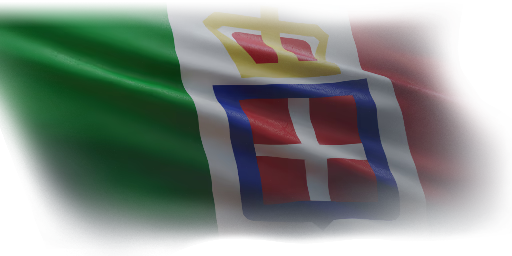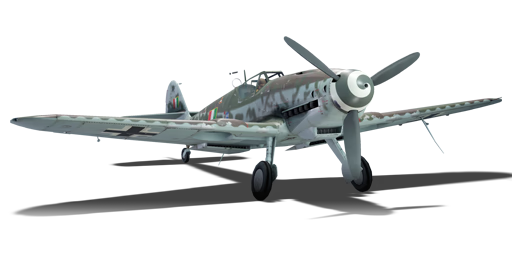




During the Second World War, with the advance of the Allies into Italy in 1943, Italy requested several vehicles from Germany including aircraft such as Bf 109 fighters to try to regain air superiority in their country and also to defend it from Allied bombing. First came the Bf 109 G-6, which was used in an attempt to destroy as many bombers as possible. On 8 September 1943, Italy was divided into two parts, the northern part of which became the Repubblica Sociale Italiana (RSI). The RSI would use other variants, including Bf 109 G-10 and G-14. Some versions of the Bf 109 G-14 were also modified with an improved cooling system and were designated as Bf 109 G-14/AS. The Bf 109s would be used until the complete liberation of Italy by the Allied forces, the Bf 109s would be transferred to Germany again in an attempt to defend the territory.
Introduced with the Italian aviation tree in Update 1.69 "Regia Aeronautica", the aircraft immediately proves to be a strong energy fighter. At low speeds it is not very capable of manoeuvring, so it is recommended to maintain speed with boom and zoom tactics to retain manoeuvrability and be able to disengage and loop back round for another pass if necessary. Thanks to the AS modification, the engine overheats less than its German counterpart. The aircraft can mount both 30 mm and 20 mm cannons, perfect for shooting down any air target. For combined battles, you can use its suspended armament consisting of bombs perfect to destroy an enemy target.
flaps
flaps
flaps
brake
| Belt | Belt filling | Armor penetration (mm) at a distance: | |||||
|---|---|---|---|---|---|---|---|
| 10 m | 100 m | 500 m | 1000 m | 1500 m | 2000 m | ||
| IT/IT/APHE/HEI | 21 | 19 | 8 | 3 | 1 | 1 | |
| IT/HEI/HEI/AP-I | 27 | 24 | 14 | 7 | 3 | 2 | |
| AP-I/HEI/HEI/HEI/HEI/IT | 27 | 24 | 14 | 7 | 3 | 2 | |
| APHE/APHE/APHE/IT | 21 | 19 | 8 | 3 | 1 | 1 | |
| FI-T/FI-T/FI-T/IT/IT | 21 | 19 | 8 | 3 | 1 | 1 | |
| HEI/HEI/HEI/APHE/AP-I | 27 | 24 | 14 | 7 | 3 | 2 | |
| Belt | Belt filling | Armor penetration (mm) at a distance: | |||||
|---|---|---|---|---|---|---|---|
| 10 m | 100 m | 500 m | 1000 m | 1500 m | 2000 m | ||
| IT/AP-T/IAI | 19 | 16 | 8 | 4 | 2 | 1 | |
| AP-T/AP-T/IT/IT/IAI | 19 | 16 | 8 | 4 | 2 | 1 | |
| AP-T | 19 | 16 | 8 | 4 | 2 | 1 | |
| IAI | 4 | 4 | 4 | 4 | 0 | 0 | |
| AP-I | 19 | 16 | 8 | 4 | 2 | 1 | |
| Belt | Belt filling | Armor penetration (mm) at a distance: | |||||
|---|---|---|---|---|---|---|---|
| 10 m | 100 m | 500 m | 1000 m | 1500 m | 2000 m | ||
| HEI-T/I | 6 | 6 | 6 | 6 | 6 | 6 | |
| HEI-T/HEI-T/HEI-T/HEF-I | 4 | 4 | 4 | 4 | 4 | 4 | |
| HEI-T/HEI-T/HEI-T | 4 | 4 | 4 | 4 | 4 | 4 | |
| HEI | 4 | 4 | 4 | 4 | 4 | 4 | |
| Belt | Belt filling | Armor penetration (mm) at a distance: | |||||
|---|---|---|---|---|---|---|---|
| 10 m | 100 m | 500 m | 1000 m | 1500 m | 2000 m | ||
| IT/AP-T/IAI | 19 | 16 | 8 | 4 | 2 | 1 | |
| AP-T/AP-T/IT/IT/IAI | 19 | 16 | 8 | 4 | 2 | 1 | |
| AP-T | 19 | 16 | 8 | 4 | 2 | 1 | |
| IAI | 4 | 4 | 4 | 4 | 0 | 0 | |
| AP-I | 19 | 16 | 8 | 4 | 2 | 1 | |












Flight performance | |
|---|---|
Survivability |
|---|
Weaponry | ||
|---|---|---|